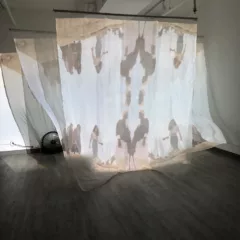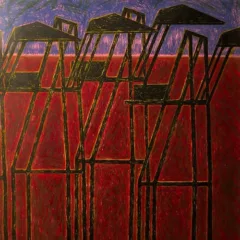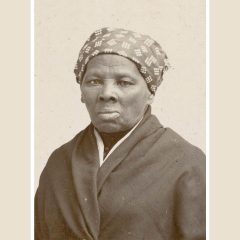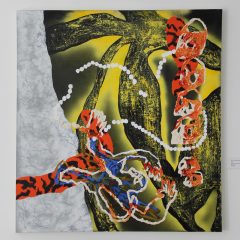Remnants of Another starts and ends cyclically, in a multi-media culmination of Indo-Caribbean ways of life, powered by the strength and ties of women and the cultural elements that bind them. On an afternoon at Twelve Gates Gallery, the light from the window illuminates the painted figures or those depicted through the digital image to evoke a neverending story of cultural preservation.
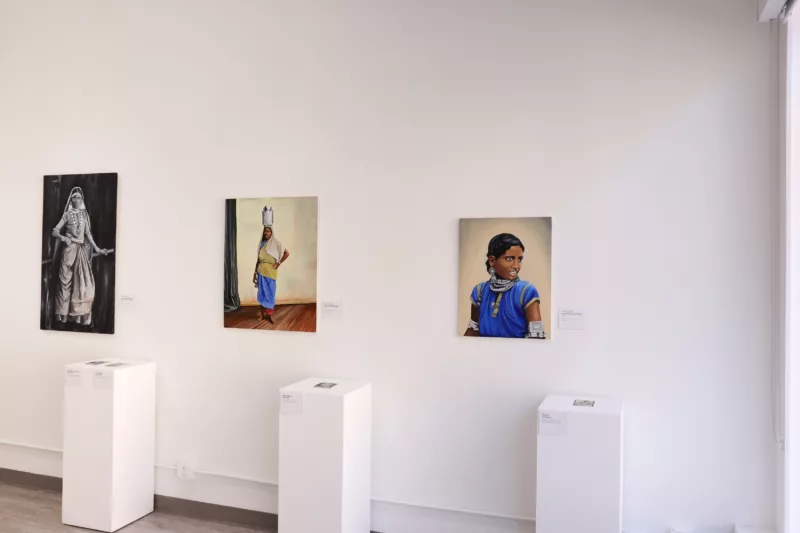
Eunoobia, Suriname (Personal collection of Nazrina Rodjan) and Hindustani women, Suriname (University of Pennsylvania Indo-Caribbean Collection). Courtesy Twelve Gates Arts
Jahaji Indentured Laborers is the full official term for ethnic South Asian people primarily from the regions of Bengal, Uttar Pradesh, Bihar, and the then Madras presidency brought over from British India to the British, French, and Dutch-occupied colonies in the Caribbean. After the 1833 Slavery Abolition Act that halted the de jure functions of the Transatlantic Slave Trade from West Africa, the European colonial superpowers sought other official methods to bring subjugated laboring groups familiar with strenuous agrarian work in muggy wealth to tend to the Caribbean sugarcane cash crop plantations. Many ethnically South Asian British Raj subjects seeking survival from impoverished colonial conditions, especially caste-marginalized groups facing the brunt of poverty and colonial laws, were brought to the Caribbean with an indentured contract, to toil with no salary, to repay a stated loan given on their lives. The Indentured Laborers brought with them the cultural elements, varied from the diverse regions in South Asia they were from, and embarked on their quest for survival through cultural adaptation. Their descendants, like the artists in the exhibit, hone the cultural elements to create their work.
The Twelve Gates Arts gallery in Old City, is an art space dedicated to showcasing the prolific talents of artists of South, Central, and West Asian descent. This exhibit, in particular, involves the participation and curation of women, queer, and non-binary artists. From right to left in the gallery, the exhibit is staged to show a narrative story cut by two videos and a stalk of sugarcane brought by the curator Suzanne Persard.
In the first corner of the space, the viewer is invited to witness this historical journey, starting with three paintings of Indo-Caribbean women by Nazrina Rodjan arranged in descending size paired with the original archival photos they were referenced from courtesy of the University of Pennsylvania Indo-Caribbean archives and the artist’s personal collection. Each painting reanimates and personifies images of some of the first women who arrived on the Caribbean islands as Indentured Laborers. Each figure is regal, their backgrounds and jewelry painted in gold and eyes painted with a lively, humanizing glint of white. The depictions colorize the historical photographs in the way they can be imagined and met in the gallery space as real people with real stories.
Next to Rodjan’s work, a short film titled “Body Subpoena” by Sarah Rohan Drepaul invokes slices of life in Richmond Hill, New York, a neighborhood heavily populated by Indo-Caribbean people. The video shows an older woman cooking for a younger one; follows the younger subject around their home; and shows her watching from many framed peepholes and snapshots as a grandmother prepares a meal. In snapshots of a hairbrush, a pastel mirror, some Hindu god idols, a busy street dotted by men wearing black kurtas (a long cultural tunic), flashy jewelry, and home decor, the viewer can piece together a childhood combined by as many complicated elements as a dually-diasporic identity that was formed out of adaption.
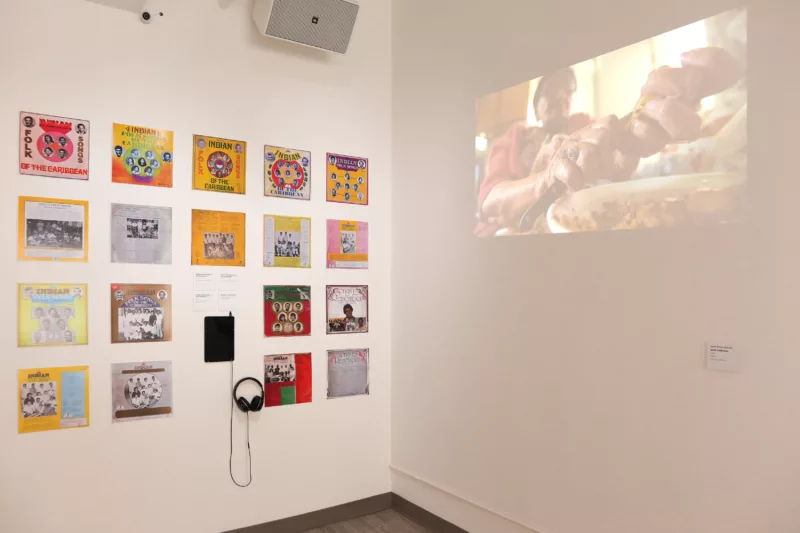
To its left, the curator installed many vinyl album covers of Indo-Caribbean folk songs on the wall from her personal collection with headphones attached to a tablet for listening. Indo-Caribbean music, combined of many South Asian musical structures like religious chants and Caribbean Hindi lyrics with Afro-Caribbean music forms and beats like soca, reinstates the importance of cultural preservation to highlight the descendants of Indentured Laborers. The covers of the albums lined the walls colorfully, an archival testament to the importance of Indo-Caribbean culture that has evolved over time, now safe-kept via physical copies of the vinyl records by the curator and now digitized copies to share with visitors. The sonic aspect of this exhibit felt like a blend of many different cultures to forge a new, unique identity similar to its ancestral art forms but rich in its own new history and traditions.
In a video installation by Vanessa Golden, titled “Ma”, perhaps dedicated as an ode to her mother and all she’s seen, an older woman sits and eats at a table adorned with snapshots of her sweet, thinning ponytail. A curtain floats above a sink near a breezy window, the same breeze drifting over a Trinidadian city from one still angle, and the familiar call of chatter of a loud family is heard as if it comes from another room in the distance. The sound carries over through the gallery in a perpetual family conversation. It adds a slice-of-life character to the entire exhibit, which continues to work together and tell a story of preservation and evolution.
“Ma” stands in contrast to “Body Subpoena”, which shows another relationship between womanhood and generations perceiving their own culture and family dynamics but in the backdrop of the Caribbean instead of an Indo-Caribbean community that has found belonging again on wholly different land mass.
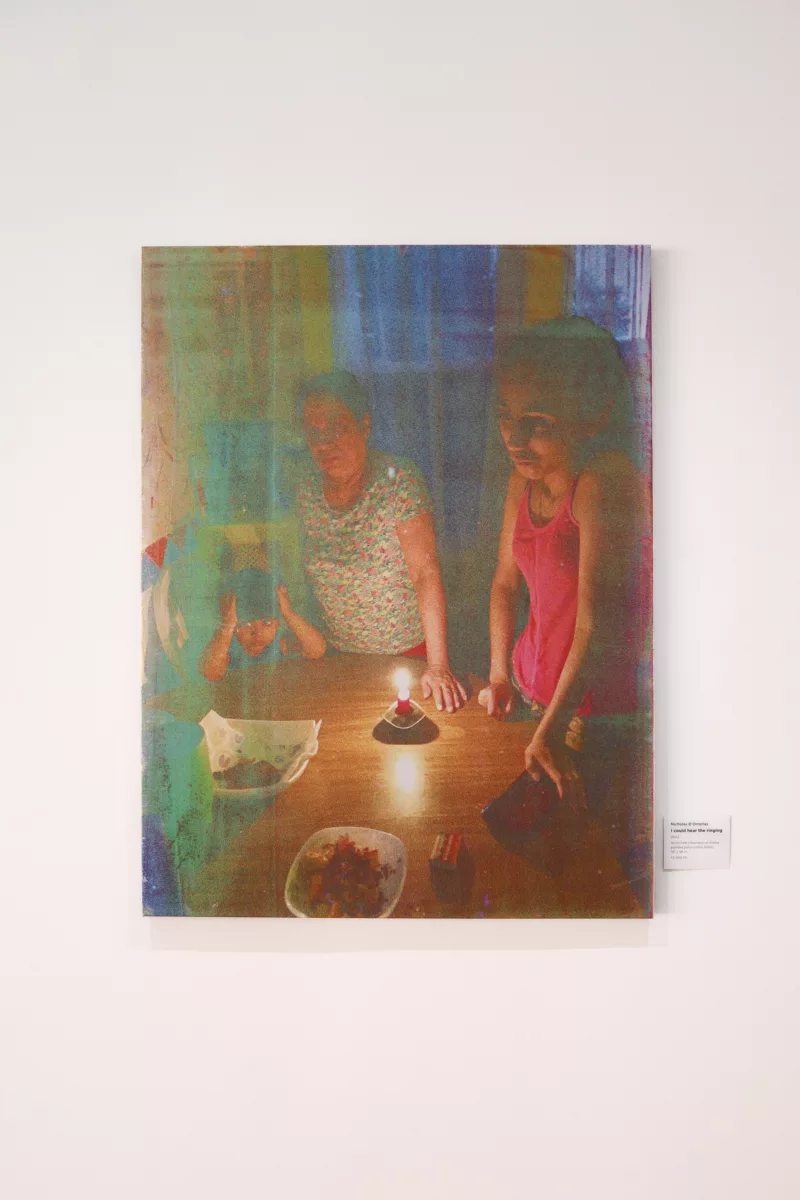
Finally, Nicholas D’ornella’s artwork plays with how families, especially the Indo-Caribbean families from his experience, are woven together through the fabric of their own familiarity and comfort like in woven fabrics. His artworks on stretched silk screens are reminiscent of pointillism up close, the figures are almost unrecognizable, and become portraits of Indo-Caribbean people further away. His pieces, like in his piece “I could hear the ringing”, show day-to-day life for Indo-Caribbean people as a product of cultural community performing tasks like celebrating a birthday, up close becoming as many dots as the many complex, hard-won elements that shape Indo-Caribbean lives.
As the entire exhibit tells a story, part archival lesson and part glimpse into many perspectives, it unmistakably shows the relationship of how the ties between women and gender non-conforming people were crucial to cultural survival. From the portraits of Indentured Laboring women to the short films showing the relationships between women to the figures D’ornella depicted together, the exhibit highlights the strength of women between each other, no matter when or where their space and place in history.
While this exhibit is no longer on view, take the time to familiarize yourself with Indo-Caribbean history and the historical events surrounding Indentured Labor. Visit the Twelve Gates Arts website to learn more about each individual participating artist.


